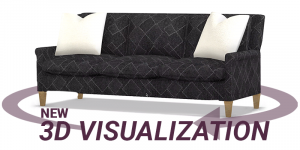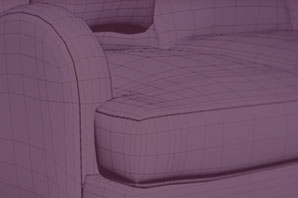The supply chain as we know it has been around for at least a couple hundred years. And while it’s worked during that time, it wasn’t designed for, nor is it easily adapted to, the modern furniture-buying process. In that process, one-half to three-quarters of a buying decision and sometimes even the purchase itself is made online. Given the gravity of the change, it’s no wonder that newer companies often overtake manufacturers using legacy supply chain systems. And this is only one major area where established manufacturers are finding that they need to streamline business operations to survive.
Challenges are forcing us to re-think everything. That includes the sales funnel, managing customer expectations and even our relationship with dealers. In light of the challenges faced, let’s explore 8 ways that home furnishing brands can streamline business operations to meet current demand and move confidently into the future.
Employing Advanced Analytics
You’ve long relied on some form of data to track things like trends, inventory and customer demand. But today analytics has reached the quantum realm.
With the right systems in place, a business can gather data at the individual and transaction level to better understand different target customers. And the automated aggregation and prioritization of data has made what would otherwise be overwhelming amounts of information that no single person or team could ever hope to discern or use, manageable, useable and very useful. Data comes in two primary forms, each with different uses for your company.
Delayed Data Analytics
Delayed data is used to establish longer-term strategies like those that increase supply chain visibility and predict long-term trends that help you guide your brand into the future.
When you use data to improve your visibility, you make more data-driven decisions. You more effectively allocate resources throughout your organization. You optimize operational speed while cutting waste in the process. You improve the experience for both dealers and their customers. And as a bonus, your own employees find themselves working for a company that’s organized, stable and ready to meet market challenges head-on.
When you run this kind of tight ship thanks to data-driven decision-making, more dealers seek you out for a partnership, shortening the time it takes from lead-attraction to closing new dealer deals.
Real-Time Data 
Real-time data often works on a more micro-level. It helps you better understand what the end-customer wants and how you can deliver that experience. It helps you track and predict demand and ensure you have the supply to meet those demands.
It helps you provide the best support to your dealers. When you do this you ensure a very fruitful experience for all involved.
Real-time data can also help you tremendously when you’re trying to figure out how best to connect with dealers and customers. You can act fast on furniture trends and events to create new opportunities to expand your brand exposure.
You may be thinking right now that you don’t have the time and resources to work on this more fast-paced and individualized level. There’s too much work to be done. But as we explore how to streamline business operations, you’ll find that across the board your employees have a lot more time on their hands to manage real-time data-driven initiatives.
Handling Industry Disruption
Emerging technologies like machine learning, advanced 3D visualizations, artificial intelligence, Internet retail and automation are changing how manufacturers do business. And “retrofitting” an existing business is often more difficult than starting fresh. This gives newer companies a slight upper hand.
Handling these kinds of industry disruptions becomes easier when you start making smaller but continual investments in your infrastructure and technology. When you have the data to make these kinds of decisions, it’s easier to plan ahead and move at a pace that’s less disruptive to business operations. That saves you time, money and stress (for everyone).
This isn’t to say that you may not need to make major changes if your business is still living in the pre-Internet era. But going forward, you’ll be more agile as a company.
Taking a company from the early 2000’s technology and systems to more current innovation to meet modern customer and business is no doubt overwhelming. But when you work with a company like MicroD, we can help you explore the cost-benefit of various technologies and customized develop a plan to implement newer technologies that streamline business operations, pay for themselves in a short time and prepare you for the future.
Things like machine learning and better systems mean little if you’re not getting in front of more dealers, so let’s look at how to streamline business operations through brand awareness.
Fueling Brand Awareness
How do you expand your dealer network? How do you get it in front of more retail customers? You do so by creating demand from their customers.
We don’t have to tell you that the Internet has changed everything. You likely buy on Amazon instead of going to the store more today than you once did. The Internet has opened up access to information for almost everyone.
People no longer learn about new brands from a salesperson or by going into a retail location. They learn about the brand on the Internet first through Facebook, Pinterest and Google as well as dealer and brand websites.
Today, you have more control than ever over how dealers and their customers see your brand. Building a strong multi-channel presence online allows you to communicate who you are and what you have to offer.
The Omnichannel Experience
Today, brands aren’t just behind the scenes supplying retailers and then allowing them to take it from there. A brand can and should be present throughout the furniture buyer’s journey.
Omnichannel platforms include things like:
- A fast and user-friendly website
- Social media presence
- High visibility in searches through SEO and SEM
- Creating content that supports dealer and customer decision-making
- Streamlining t how dealers keep your current product catalog
The omnichannel experience creates a magnet in which dealers seek you out. Customers are searching for your brand on their sites. They’re asking for you by name. They already know what they want to buy and why they want to buy it because:
- They’ve already found accurate and helpful brand information online
- They see others appreciating your brand online. This creates positive social pressure to choose your brand.
Capture dealer leads through your website with a simple contact form and your sales team can do the rest. Now, let’s see what you can do to ensure that once you’ve closed that deal with a dealer, you can deliver the best experience to maintain a strong relationship and increase revenues for the both of you.
Bridging the Gap Between Brand and Dealer
The relationship between brands and dealers has changed dramatically for the above reasons. Having a brand more involved from an earlier stage in the buyer’s journey can create a lot of chaos if you don’t streamline business operations between yourself and dealers.
Next, we’ll look specifically at several ways you can do that.
Using 3D & Product Visualizations
Humans are very visual. This goes for dealers and customers. But paper catalog and even online images don’t do justice to your products. You can only see one side of the product in most cases.
3D visualizations can increase furniture buying conversions by 20%. No special glasses or VR headsets required. 
Online 3D visualizations allow a dealer or customer to use their mouse, or finger, to move the image around to see all sides. You can add product draping so that viewers can see the product in the different colors and designs available with just one click. How much more powerful is that than saying, “this comes in red, teal, and canary yellow”?
They get a better feel for what this product actually looks like in their showroom or home.
Dealers and customers know exactly what they want and what to expect when the product arrives. They’re not only more likely to buy. They’re more likely to love what they receive. That means fewer returns and better reviews for brand and retailer.
Product Catalog Data Delivery
When retailers showcase more up-to-date and accurate products on their site, they can sell more of your brand. But keeping product catalogs and online products up-to-date online is even more challenging for retailers than it is for you because they’re working with so many brands.
Streamlining how you communicate new product lines and changes to dealers save them time and money. At the same time, it:
- Gets your latest lines in front of customers faster
- Ensures accurate representation across retailers
This translates to more sales.
Automate the digital catalog data process to communicate directly with dealer websites in real-time. Cut out the middle-man work of manually transferring information to streamline business operations for both of you.
Improve Dealer Order Processes
Shameless plug. My| FurnishWEB helps manufacturers empower retailers to sell more of their products. This state-of-the-art tool is built around the real-world furniture supply chain experience. It streamlines how manufacturers manage dealers, designers, and sales reps. For years, My|FurnishWEB’s centralized approach has been helping manufacturers cut costs, streamline business operations and improve customer experience throughout the supply chain.
Keep everyone on the same page through a streamlined communication process. Communicate with dealers, designers and sales reps regarding orders, shipments, service requests, pricing options and more.
And anyone in the company can easily pick up where someone else left off. So you’re no longer have a sales rep playing phone, or email, tag. You’re no longer forcing partners to re-explain their challenges or needs over and over to get them resolved.
Electronic Data Interchange (EDI)
EDI is an automated electronic exchange of business information between your brand and your dealers. Using a standardized format, two businesses can seamlessly communicate updates and information to each other. The two businesses on either side of an EDI are known as trading partners.
In most cases, two trading partners are working in different systems that don’t naturally communicate with each other. But that’s not a problem with an EDI. It can “translate” information back and forth so that when received it’s always in the most useable form for brand or dealer.
Benefits of an EDI
A cloud-based EDI system can:
Get Rid of Mind-Numbing Work. When two businesses share information without an EDI, you generally need a person or people to translate and transfer information into a usable form. This work is tedious and boring to an employee. An EDI takes this “mind-numbing” work out of the equation to free up your talented employee for more stimulating and productive work like managing exceptions and solving problems.
Reduce Errors. Manual data transfer is also highly-susceptible to human error. Mundane work causes people to tune out what they’re doing even though accuracy is highly important. Because an EDI automatically translates the information, you take the potential for human error out of it.
Streamline Processes. With swift and clear communication between systems, you can focus on streamlining the processes around that information.
Recognize Consumer Trends. When everything is automated, it’s easier to employ artificial intelligence to identify subtle trends that you may be missing when one or more people are mindlessly transferring data.
Better Manage Supply and Demand. With better trend-tracking, inventory turns faster, reducing warehousing costs and maximizing returns.
Manage All Dealers in One Place. No more running around with the left hand not knowing what the right is doing. Everything is all in one place. You can even compare retailers to each other.
Make It Work with Any System. Unless your current system is a person with a pen and pad of paper, an EDI can be configured to help the two systems flawlessly speak to each other. EDIs work with RMS, ERP and other business systems.
Streamline Business Operations
Today’s manufacturers face many challenges that simply didn’t exist in yesteryears. It’s nudging manufacturers who need to stay relevant into a new way to do things. The Internet has completely changed how people buy furniture. This not only impacts your dealers. It impacts you.
In order to face new challenges, manufacturers have to streamline business operations with new tools and technologies. But they also need to look at how their partnerships with dealers can evolve to benefit everyone involved. Employing advanced analytics, enhancing product visualizations, automating communication of online catalog data, and cutting out a lot of the mundane manual data processing can help you cut the waste and increase productivity.
To learn more about how we help manufacturers streamline business operations to achieve these business milestones for manufacturers, contact us to schedule a demo and discuss how we can customize a plan to meet your business needs.





